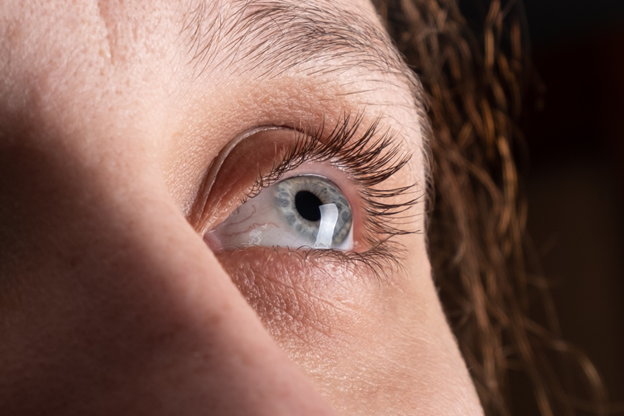Keratoconus is an eye condition where the cornea becomes thin and bulges outward. This can cause vision issues over time. Early detection is key to managing it successfully. By spotting the condition early, treatment can start sooner, slowing down its progression. It’s crucial to know the steps to identify and tackle this eye ailment. Understanding the importance of early recognition and control can help in maintaining better eyesight and delaying advancement of the disease.
Understanding the Nature of Keratoconus Progression
Keratoconus causes include both genetic factors and environmental influences. Some people are more prone due to their family history. Environmental elements, such as constant eye rubbing, may contribute too. The illness usually starts with mild vision blurriness and sensitivity to light. Over time, it can lead to more severe vision problems if not treated. The timeline of keratoconus symptoms can vary; for some, it advances slowly, while others might notice rapid changes. Knowing how these factors come into play can prepare you to act and manage keratoconus effectively.
Key Prevention Strategies for Managing Keratoconus
A. Avoid Eye Rubbing
Rubbing your eyes can worsen keratoconus symptoms. It puts pressure on the cornea, speeding up its thinning process. To break this habit, keep your hands clean and moisturized to prevent irritation. If your eyes itch, gently use a clean, wet cloth to soothe them. These small changes can make a big difference in controlling keratoconus.
B. Effectively Manage Allergies and Eye Irritation
Common triggers for allergies include pollen and dust. These can make keratoconus worse by causing you to rub your eyes. Managing these allergies is essential. Consider allergy medications or natural remedies like saline rinses. Consult an eye care professional for advice on keeping your eyes comfortable and irritation-free.
C. Protect Your Eyes from Harmful UV Radiation
Ultraviolet (UV) rays can impact your cornea negatively. Protecting your eyes from UV light is important in controlling keratoconus progression. Wear sunglasses that block both UVA and UVB rays. These not only help maintain corneal integrity but can also prevent further damage to your eyes from sun exposure.
D. Adopt a Healthy Lifestyle for Good Eye Health
Eating healthy plays a role in managing keratoconus. Include foods rich in vitamins A, C, and E in your diet. Leafy greens and citrus fruits are good options. Managing keratoconus can also benefit from antioxidants found in nuts and berries. These help in keeping your eyes healthy and may slow down the progression of the condition.
Early Detection and Regular Monitoring
Regular eye check-ups are crucial. Visiting an optometrist or ophthalmologist lets you track changes in your vision. The keratoconus diagnosis process might use advanced tools like corneal topography. These tests map the surface of your eye, offering a clear picture of any changes. Continuous monitoring ensures keratoconus does not progress unchecked, allowing for timely interventions.
Corneal Cross-Linking (CXL) Procedure
This is a treatment designed to strengthen the cornea. Keratoconus treatment options like CXL have shown success. It involves using vitamin B2 and UV light to fortify the corneal tissue. While success rates are promising, not everyone is eligible. Discuss with a healthcare provider to see if it’s suitable for you and what you can expect from this procedure.
Contact Lens Solutions for Vision Correction
Contact lenses specially designed for keratoconus vision correction provide improved clarity. Types include rigid gas permeable lenses and scleral lenses. These lenses support the cornea and improve vision. Maintaining proper lens hygiene is crucial. Clean them regularly to extend their life and effectiveness.
Exploring Emerging Treatments and Research
Research in keratoconus treatment options is ongoing, offering hope for new solutions. Emerging therapies may target the condition differently and could improve keratoconus prognosis. Keeping an eye on clinical trials and new studies can provide additional options in managing keratoconus more effectively.
Making Lifestyle Adjustments for Daily Living
Living with keratoconus means adjusting daily habits for better eye health. Use protective eyewear during activities that might strain your eyes. Join support networks where you can share experiences and get advice. Access to resources and communities can make day-to-day management easier.
Conclusion: Embrace Proactive Strategies
Adopting preventive measures is essential. These strategies play a critical role in maintaining better vision. Staying proactive helps ensure a positive keratoconus prognosis. Effective management means regularly implementing these actions to protect your vision over time.
Take Charge of Your Eye Health
Schedule regular eye exams to keep your vision in check. Staying informed about keratoconus causes and treatments empowers you. Engage with eye care professionals to explore tailored solutions and take control of your eye health today. For expert care and personalized treatment options, visit Eswar Eye Hospital.


